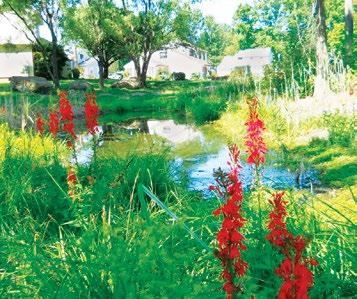
2 minute read
Communities and Corporations Involve
By Laura Whalen, Habitat Consultant, and Debbie Heaton, Director of Development, Partnership for the Delaware Estuary
The Delaware Estuary provides many of the resources necessary to fuel the economies of three states. This makes a healthy Delaware River and Bay essential to the people who live here and the businesses that have chosen to locate here. The Partnership for the Delaware Estuary (PDE) brings the needs of these two communities together each year through the Corporate & Community Environmental Stewardship Program. The program supports local businesses and governments in their planning of projects to reduce their environmental impact and to conserve and provide habitat on their properties or in their communities. The projects allow employees to get involved and, in some cases, volunteers from the community are recruited to participate and get their hands dirty.
Advertisement
The projects accomplished in 2014 cover a wide range of efforts, and all serve to benefit the health of the estuary. The PDE staff provided technical, planning and organizational help to the projects’ leaders and worked alongside volunteers during the course of each effort.
In 2014, Delaware’s New Castle County (NCC) worked with the PDE to improve a stormwater pond at Rockwood Park. County employees prepared the soil for planting, and volunteers from Rockwood and Bank of America came out to plant and create habitat around the pond for native birds, turtles, and other wildlife.
NCC Special Services is responsible for regularly maintaining 94 stormwater ponds. Bernadette Igo of NCC said, “Our goal is to incorporate one to two ponds every year and plant native vegetation in order to reduce mowing and maintenance and, consequently, our carbon footprint, and remove pollutants from our waterways. The naturalized ponds are also more beautiful as you can see from the before-and-after photos of the Dartmouth Woods project in New Castle County.”
BEFORE: A stormwater pond sits neglected in Delaware’s Dartmouth Woods neighborhood, an area that drains to Naaman’s Creek and, later, the Delaware River estuary.

AFTER: Native plants line a stormwater pond in Dartmouth Woods, a neighborhood near the DelawarePennsylvania state line. These will benefit nearby homes by absorbing more runoff, filtering more pollutants, and attracting more wildlife.

Volunteers from Pepco Holdings, Inc. worked at the Atlantic City Electric office in Carneys Point, New Jersey to remove invasive plants from a stormwater pond they maintain on its property. The invasive plants were choking out some of the native shrubs they planted in previous years and were growing too large. The employees hope to work on this buffer every year to keep it healthy.
Wheelabrator Gloucester is holding their annual Symposium for Environment and Education, and the PDE is working with it to provide technical guidance. This year, students from West Deptford Middle School are learning how protecting and restoring freshwater mussels and oysters will make water cleaner. They are also learning about living shorelines and working to implement a project that will improve mussel habitat.
Logan Generating Company continued to maintain and expand its meadow planting project in Logan Township, New Jersey. Located along the Delaware River, it consists of 31 acres of fields that were once farmland but now serve as wildlife habitat. The meadow consists of native plants, such as purple coneflower, common yarrow, switch grass, big bluestem and more. These will absorb and filter rain and snowmelt before they can flow into the Delaware River.





